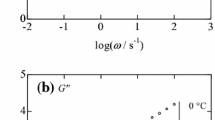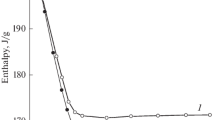Abstract
The transient entanglement networks of cellulosic polysaccharides in concentrated solutions were characterized by the molecular weight between entanglements (M e) using dynamic viscoelasticity measurements. From the concentration dependence of M e, M e for the cellulosic polysaccharides in the molten state (M e,melt) was estimated as the material constant reflecting the chain characteristics. The values of M e,melt were compared among three cellulosic polysaccharides: cellulose, methylcellulose, and hydroxypropyl cellulose. Methylcellulose and hydroxypropyl cellulose were employed as cellulose derivatives having small and large side groups, respectively. It appeared that hydroxypropyl cellulose had significantly larger M e,melt compared with cellulose and methyl cellulose. However, the numbers of repeating glucose-ring units between entanglements were very close to each other among the three polysaccharides.







Similar content being viewed by others
References
Brown W, Henry D (1964) Studies on cellulose derivatives part III. Unperturbed dimensions of hydroxyethyl cellulose and other derivatives in aqueous solvents. Makromol Chem 75:179–188
Brown W, Henry D, Ohman J (1963) Studies on cellulose derivatives part II. The influence of solvent and temperature on the configuration and hydrodynamic behavior of hydroxyethyl cellulose in dilute solution. Makromol Chem 64:49–67
Burchard W (2003) Solubility and solution structure of cellulose derivatives. Cellulose 10:213–225
Chen X, Zhang Y, Cheng L, Wang H (2009) Rheology of concentrated cellulose solutions in 1-butyl-3-methylimidazolium chloride. J Polym Environ 17:273–279
Chen X, Zhang Y, Ke F, Zhou J, Wang H, Liang D (2011) Solubility of neutral and charged polymers in ionic liquids studies by laser light scattering. Polymer 52:481–488
Doi M, Edwards SF (1986) The theory of polymer dynamics. Clarendon, Oxford
Ferry JD (1980) Viscoelastic properties of polymers. Wiley, New York
Flory PJ (1966) Treatment of the effect of excluded volume and deduction of unperturbed dimensions of polymer chains. Configurational parameters for cellulose derivatives. Makromol Chem 98:128–135
Gericke M et al (2009) Rheological properties of cellulose/ionic liquid solutions: from dilute to concentrated states. Biomacromolecules 10:1188–1194
Haward SJ et al (2012) Shear and extensional rheology of cellulose/ionic liquid solutions. Biomacromolecules 13:1688–1699
Horinaka J, Yasuda R, Takigawa T (2011) Entanglement properties of cellulose and amylose in an ionic liquid. J Polym Sci B Polym Phys 49:961–965
Horinaka J, Okuda A, Yasuda R, Takigawa T (2012) Molecular weight between entanglements for linear D-glucans. Colloid Polym Sci 290:1793–1797
Horinaka J, Urabayashi Y, Takigawa T, Ohmae M (2013) Entanglement network of chitin and chitosan in ionic liquid solutions. J Appl Polym Sci 130:2439–2443
Kamide K, Miyazaki Y (1978) The partially free draining effect and unperturbed chain dimensions of cellulose, amylose, and their derivatives. Polym J 10:409–431
Kamide K, Saito M (1987) Cellulose and cellulose derivatives: recent advances in physical chemistry. Adv Polym Sci 83:1–56
Kosan B, Michels C, Meister F (2008) Dissolution and forming of cellulose with ionic liquids. Cellulose 15:59–66
Masuda T, Toda N, Aoto Y, Onogi S (1972) Viscoelastic properties of concentrated solutions of poly(methyl methacrylate) in diethyl phthalate. Polym J 3:315–321
Meda A, Inoue T, Sato T (2013) Dynamic segment size of the cellulose chain in an ionic liquid. Macromolecules 46:7118–7124
Onogi S, Masuda T, Kitagawa K (1970) Rheological properties of anionic polystyrenes. I. Dynamic viscoelasticity of narrow-distribution polystyrenes. Macromolecules 3:109–116
Swatloski RP, Spear SK, Holbrey JD, Rogers RD (2002) Dissolution of cellose with ionic liquids. J Am Chem Soc 124:4974–4975
Syang-Peng R et al (2009) Sol/gel transition and liquid crystal transition of HPC in ionic liquid. Cellulose 16:9–17
Author information
Authors and Affiliations
Corresponding author
Rights and permissions
About this article
Cite this article
Horinaka, Ji., Urabayashi, Y. & Takigawa, T. Effects of side groups on the entanglement network of cellulosic polysaccharides. Cellulose 22, 2305–2310 (2015). https://doi.org/10.1007/s10570-015-0670-7
Received:
Accepted:
Published:
Issue Date:
DOI: https://doi.org/10.1007/s10570-015-0670-7




